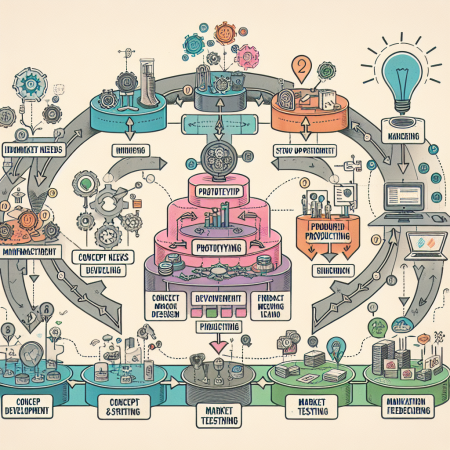How to Develop a Product Line
Product Line Development Strategies
Market Research
Before embarking on developing a new product line, it is crucial to conduct thorough market research. This involves studying consumer preferences, analyzing competitor offerings, and identifying market trends.
Market research helps in understanding the target audience, determining demand for the new products, and evaluating the feasibility of the product line in the current market scenario.
By gathering valuable insights through market research, businesses can make informed decisions and tailor their product line development strategies accordingly.
Product Conceptualization
Once the market research is complete, the next step is to conceptualize the products that will form the new product line. This stage involves brainstorming ideas, defining product features, and outlining the unique selling points of each product.
Product conceptualization also includes creating prototypes, conducting focus groups to gather feedback, and refining the product concepts based on the received inputs.
Clear and well-defined product concepts serve as a foundation for the successful development of a product line.
Supply Chain Planning
An integral part of product line development strategies is effective supply chain planning. Businesses need to ensure that they have a reliable network of suppliers, manufacturers, and distributors in place to support the production and distribution of the new product line.
Supply chain planning involves forecasting demand, managing inventory levels, negotiating contracts with suppliers, and optimizing logistics to streamline the product delivery process.
A well-structured supply chain plan helps in minimizing production delays, reducing costs, and ensuring the timely availability of products in the market.
Marketing and Promotion
Marketing and promotion play a crucial role in the successful development of a product line. Businesses need to create a comprehensive marketing strategy that outlines how they will introduce and promote the new products to the target audience.
This involves developing branding materials, identifying suitable marketing channels, setting promotional budgets, and creating marketing campaigns that resonate with the target market.
Effective marketing and promotion strategies help in generating awareness, driving sales, and establishing a strong market presence for the new product line.
Creating a Product Line
Product Line Ideation
The process of creating a product line starts with ideation, where businesses generate ideas for products that complement each other and cater to specific consumer needs or preferences.
Ideation involves brainstorming sessions, market trend analysis, customer feedback collection, and creative thinking to come up with innovative product concepts.
Businesses should focus on creating a cohesive product line that offers variety, addresses market gaps, and aligns with the brand’s positioning.
Prototype Development
After finalizing the product concepts, businesses move on to the prototype development stage where physical or digital prototypes of the products are created for testing and validation.
Prototyping helps in evaluating the feasibility of the product designs, gathering feedback from stakeholders, identifying potential improvements, and ensuring that the final products meet quality standards.
Iterative prototyping allows businesses to refine their product ideas and iterate on design elements before mass production begins.
Brand Cohesion
Creating a cohesive brand identity across the product line is essential for establishing brand recognition and fostering customer loyalty. Businesses should ensure that all products within the line are consistent in their branding elements, such as logos, colors, packaging, and messaging.
Brand cohesion helps in creating a unified brand experience for consumers, strengthening brand recall, and differentiating the product line from competitors in the market.
Consistent branding also builds trust and credibility among consumers, reinforcing the brand’s reputation and value proposition.
Quality Assurance
Quality assurance is paramount when creating a product line to ensure that all products meet predefined quality standards and deliver a positive customer experience. Business should establish quality control processes, conduct product testing, and adhere to industry regulations to guarantee product quality.
Regular quality checks during the production process, supplier audits, and customer feedback monitoring help in identifying and addressing quality issues proactively.
By prioritizing quality assurance, businesses can build a reputation for delivering reliable and high-quality products, enhancing customer satisfaction and loyalty.
Designing a Product Line
Product Line Expansion
Launching New Product Lines
FAQ
Q: Why is market research important in product line development?
A: Market research helps businesses understand consumer preferences, analyze competitor offerings, and identify market trends, which are crucial in making informed decisions and tailoring product line strategies.
Q: What role does supply chain planning play in product line development?
A: Effective supply chain planning ensures businesses have a reliable network of suppliers, manufacturers, and distributors to support production and distribution, minimizing delays and optimizing logistics.
Q: How important is brand cohesion in creating a product line?
A: Brand cohesion is essential for establishing brand recognition, fostering customer loyalty, and creating a unified brand experience across products, strengthening brand recall and differentiation.
Q: Why is quality assurance crucial in product line creation?
A: Quality assurance ensures that products meet predefined quality standards, deliver a positive customer experience, and build a reputation for reliability and high-quality products, enhancing customer satisfaction.
Q: What are some key steps in creating a product line?
A: Key steps include ideation, prototype development, brand cohesion, and quality assurance to generate innovative product ideas, test prototypes, establish consistent branding, and ensure product quality.

